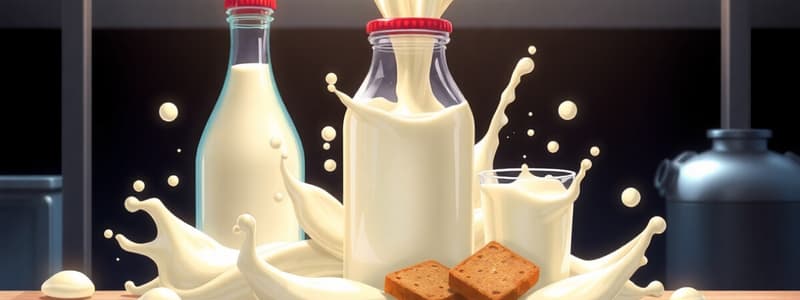Podcast
Questions and Answers
What is the minimum percentage of milk solids-not-fat (MSNF) required in whole milk?
What is the minimum percentage of milk solids-not-fat (MSNF) required in whole milk?
- 8.25% (correct)
- 10.25%
- 9.25%
- 7.25%
Which type of milk has no more than 0.5% milk fat?
Which type of milk has no more than 0.5% milk fat?
- Flavored Milk
- Reduced-Fat Milk
- Fat-Free or Nonfat Milk (correct)
- Whole Milk
Which milk type is characterized by being dehydrated up to about 97%?
Which milk type is characterized by being dehydrated up to about 97%?
- Flavored Milk
- Cultured Milk Products
- Whole Milk
- Dry Milk (correct)
What must cultured milk products contain to ferment lactose into lactic acid?
What must cultured milk products contain to ferment lactose into lactic acid?
Which two cultures must be included in yogurt according to U.S. regulation?
Which two cultures must be included in yogurt according to U.S. regulation?
What ingredient is commonly added to eggnog milk to enhance its flavor?
What ingredient is commonly added to eggnog milk to enhance its flavor?
Which type of milk has a fat level decreased to 1.0%?
Which type of milk has a fat level decreased to 1.0%?
What is the primary purpose of adding a flavoring agent to flavored milk?
What is the primary purpose of adding a flavoring agent to flavored milk?
What is the acidity level (pH) range of fresh milk at 25°C?
What is the acidity level (pH) range of fresh milk at 25°C?
Which factor is NOT a contributor to the color of milk?
Which factor is NOT a contributor to the color of milk?
What is the purpose of pasteurization?
What is the purpose of pasteurization?
Which method uses temperatures at or above 280°F (138°C) for at least 2 seconds?
Which method uses temperatures at or above 280°F (138°C) for at least 2 seconds?
What is the typical freezing point of fresh milk?
What is the typical freezing point of fresh milk?
How does homogenization affect the properties of milk?
How does homogenization affect the properties of milk?
What is the boiling point of fresh milk?
What is the boiling point of fresh milk?
What indicates the successful pasteurization of milk?
What indicates the successful pasteurization of milk?
Which type of bacteria is primarily used in the production of yogurt?
Which type of bacteria is primarily used in the production of yogurt?
What is the main characteristic of kefir compared to yogurt?
What is the main characteristic of kefir compared to yogurt?
Which of the following statements about sour cream is accurate?
Which of the following statements about sour cream is accurate?
What percentage of fat content is found in cream?
What percentage of fat content is found in cream?
What effect does sugar have on whipped cream stability?
What effect does sugar have on whipped cream stability?
During the whipping process, what happens to the volume of cream?
During the whipping process, what happens to the volume of cream?
What temperature range is optimal for incubating yogurt during production?
What temperature range is optimal for incubating yogurt during production?
What process is involved in creating acidophilus milk?
What process is involved in creating acidophilus milk?
What is the primary method used to produce butter from pasteurized cream?
What is the primary method used to produce butter from pasteurized cream?
What type of emulsion does butter transition to during its production process?
What type of emulsion does butter transition to during its production process?
What ingredient is typically removed in the process of making ghee?
What ingredient is typically removed in the process of making ghee?
For how long should unopened aseptic packages of UHT pasteurized milk be stored?
For how long should unopened aseptic packages of UHT pasteurized milk be stored?
What can trigger oxidation in milk, leading to off-flavors and loss of riboflavin?
What can trigger oxidation in milk, leading to off-flavors and loss of riboflavin?
What is the recommended best consumption time for yogurt after purchase?
What is the recommended best consumption time for yogurt after purchase?
How long can opened ultrapasteurized milk be stored once opened?
How long can opened ultrapasteurized milk be stored once opened?
What happens to buttermilk during storage after purchase?
What happens to buttermilk during storage after purchase?
Which cheese classification has a moisture content over 80%?
Which cheese classification has a moisture content over 80%?
What is the primary factor influencing the classification of cheese?
What is the primary factor influencing the classification of cheese?
Which of the following methods is NOT commonly used to aid coagulation in cheese production?
Which of the following methods is NOT commonly used to aid coagulation in cheese production?
Which step in cheese production significantly influences the texture of curd?
Which step in cheese production significantly influences the texture of curd?
What occurs during the ripening phase of cheese production?
What occurs during the ripening phase of cheese production?
What is the yield ratio of cheese produced from milk?
What is the yield ratio of cheese produced from milk?
Which USDA grade indicates the highest quality of cheese?
Which USDA grade indicates the highest quality of cheese?
Which process involves exposing cheese to controlled temperature and humidity?
Which process involves exposing cheese to controlled temperature and humidity?
Flashcards are hidden until you start studying
Study Notes
Milk Properties
- Fresh milk has a pH of 6.5-6.7 at 25°C
- The viscosity of milk depends on fat content, size of fat globules and clustering
- Homogenization and aging affect viscosity
- Milk's freezing point is -0.55°C and boiling point is 100.2°C
Milk Color and Flavor
- Milk's light ivory color is attributed to fat, casein and calcium complexes, and riboflavin (B2)
- Carotene in milk contributes to the yellowish tinge of butter
- Milk's flavor is mild and slightly sweet
- Emulsified milk fat, proteins, lactose, and salts contribute to milk's mouthfeel
- Fresh milk also contains acetone, acetaldehyde, methyl ketones, and SFAs, influencing its aroma
Milk Terminology
- Pasteurization is a heat treatment process used to eliminate pathogens and extend shelf life
- Pasteurization destroys 100% of pathogenic bacteria, yeasts, and molds, and 95-99% of nonpathogenic bacteria
- Inactivation of alkaline phosphatase is a marker of successful pasteurization
- Ultrapasteurization involves heating milk at or above 280°F (138°C) for at least 2 seconds
- Ultrahigh-temperature (UHT) milk is pasteurized at very high temperatures, aseptically sealed, and can be stored unrefrigerated for up to 3 months
- Homogenization is a mechanical process that breaks down fat globules into smaller, permanently dispersed particles
- Coagulation refers to the clotting or solidifying of milk, often caused by denatured proteins separating from the liquid
Types of Milk
- Whole milk must contain 3.25% milk fat and at least 8.25% milk solids-not-fat (MSNF)
- Whole milk may be fortified with vitamins A and D
- Reduced-fat and low-fat milk have decreased milk fat levels of 2.0% and 1.0% respectively
- Fat-free or nonfat milk contains no more than 0.5% milk fat
- Goat's milk is low in folate and vitamins D, C, and B12
- Flavored milk is created by adding flavoring agents and sugar to milk
- Eggnog milk is a rich holiday beverage made with eggs, cream or milk, nutmeg, and often spirits
- Dry milk is made with whole or skim milk dehydrated to about 97% by spray or vacuum drying
- Instant milk is different than regular nonfat dried milk, manufactured by exposing dried milk to steam before redrying
- Cultured milk products are fermented using bacteria cultures, converting lactose into lactic acid
- Yogurt in the U.S. must contain Lactobacillus bulgaricus and Streptococcus thermophilus cultures
Milk Products
- Buttermilk is the liquid left over after churning cream, but now is often cultured with Streptococcus lactis bacteria
- Yogurt is produced by mixing Lactobacillus bulgaricus and Streptococcus thermophilus with pasteurized, homogenized milk
- Acidophilus milk is a cultured milk created with Lactobacillus acidophilus
- Kefir is a fermented dairy beverage with a mixed flora of yeasts, LAB, and acetic acid bacteria
- Sour cream is cream soured by Streptococcus lactis bacteria or an acidifying agent
- Creams vary in fat percentages and can be replaced by substitutes
- Whipping air into liquid milk products creates foams
- Whipped cream expands multiple times its original volume, stability influenced by fat content and temperature
- Sugar increases whipped cream stability but should be added gradually
- Over-beating turns whipped cream into butter and whey
Butter
- Butter has a fat content of about 80%
- Made from sweet or sour cream through churning, which breaks fat globules, causing coalescence and water separation
- Butter's color can be attributed to carotene or additives
- Butter spoilage occurs through hydrolysis of TG molecules, releasing butyric and caproic acids
- Ghee is clarified butter, prepared by simmering butter and removing residue
Storing Milk Products
- Most fluid milk, except unopened UHT packages, should be refrigerated
- Avoid drinking directly from the container to minimize contamination
- Store milk in opaque containers to reduce light exposure and prevent oxidation
- Opened milk, yogurt, buttermilk, and sour cream have limited shelf lives
- Dry milk, ultrapasteurized milk, evaporated milk, and sweetened condensed milk are stored at or slightly below room temperature
- Unopened evaporated and sweetened condensed milk can last up to a year at room temperature, double that if refrigerated
- Ultrapasteurized milk can be stored unopened at room temperature for up to 3 months
Cheese
- Cheese is classified based on moisture content: soft, semi-hard, hard, and very hard
- The yield from 10 pounds of milk is approximately 1 pound of cheese
Cheese Production
- Cheese production involves key steps: milk selection, coagulation, curd treatment, curing, and ripening
- Cheese can be made using milk from any mammal
- Milk coagulation occurs through the action of enzymes or acid
- The texture of curd is influenced by pH, becoming more solid with increased acidity
- Curd treatment includes cutting, heating, salting, and sometimes knitting or pressing
- Curing involves controlled temperature and humidity during aging
- Ripening refers to the chemical and physical changes during curing
- Processed cheese is blended cheese, with or without other ingredients
Purchasing Cheese
- Cheeses are graded by the USDA into categories: AA, A, B, and C
- Graded cheeses are evaluated on variety, flavor, texture, finish, color, and appearance
Studying That Suits You
Use AI to generate personalized quizzes and flashcards to suit your learning preferences.




